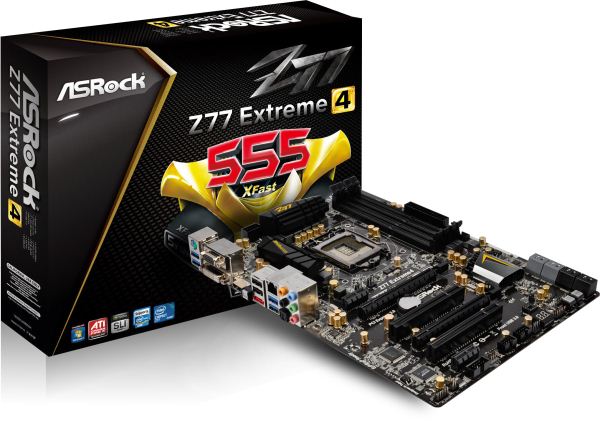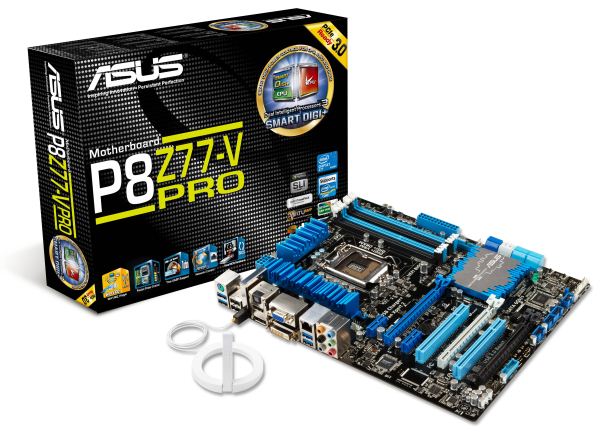Intel Z77 Motherboard Review with Ivy Bridge - ASRock, ASUS, Gigabyte, and MSI
by Ian Cutress on May 7, 2012 7:40 PM EST- Posted in
- Motherboards
- MSI
- Gigabyte
- ASRock
- Asus
- Ivy Bridge
- Z77
Conclusion – ASRock Z77 Extreme4
I had high expectations of the ASRock product due to what we have seen in previous chipsets. Over time, they have developed this knack of offering a good performance product at a great price, and a large amount of free kit in the box to sweeten the deal.
The Z77 Extreme4 is the lower end enthusiast board coming out from ASRock at release (compared to a total 20 models listed on their website). Therefore, when it comes in at $135, we should like this price. In the box is not substantial, with just a pair of SATA cables and an SLI finger, but we are treated to the ASRock BIOS and Software package. The big addition on the package is the Internet Flash software, allowing users to update their BIOS to the latest without needing to download it in an Operating System.
Performance wise, ASRock seem to be lacking the enhanced Turbo option utilized by other motherboard manufacturers by default, so we may see it in future BIOS builds. The XFast LAN software also shows superior performance in incompressible transfers or real-world transfers compared to standard USB throughput.
By making this board a little bit smaller than ATX, this board is cheaper than the rest and I really like the styling. As long as you remember to adjust the default CPU fan speed, this inexpensive board would be a good choice for an Ivy Bridge build.
Conclusion – ASUS P8Z77-V Pro
Whenever a reviewer deals with a variety of products at different price points, thoughts go through the mind of a reviewer about where that additional money has gone. If you look at an ASUS board, the usual culprits pop up - vastly improved fan controls, superior BIOS and software, digital power delivery, and a general feel that the board is solidly built. ASUS has gone another step further with their Z77 range, and on the Pro this means an Intel NIC as standard, onboard WiFi, USB Flashback, all four Ivy Bridge video outputs available, USB 3.0 Boost, Q-LED for POST diagnosis, and even a Thunderbolt header which connects to a future ASUS Thuderbolt add-in card (sold separately).
Performance on the P8Z77-V Pro is bolstered by the MultiCore Enhancement BIOS setting, which invokes maximum turbo mode for any core loading by default giving multi-threaded results an advantageous score. I feel this sort of setting will quickly become the standard, as motherboard manufacturers try to provide the best bang for buck on their products.
Despite the mishap regarding my CPU cooler (which is of an old design), there is not much I can complain about on the P8Z77-V Pro. It overclocked a set of G.Skill DDR3-2666 memory to DDR3-2950 with a little increase in voltage without issue, and it overclocked the CPU rather vigorously to give 4774 MHz, even if it was a little toasty under load.
At $225/$235, the motherboard spectrum for Ivy Bridge will separate the very cheap and the very functional. For a long-term build, the ASUS P8Z77-V Pro is a solid choice, and even has ASUS Premium Service warranty if you are in North America.
Update: I have just been informed that the Pro will soon drop in MSRP to $209. This makes it even more affordable.












117 Comments
View All Comments
Zoomer - Monday, May 14, 2012 - link
Construction quality analysis would be a good addition, imo. Perhaps the mobo roundups can be done by a team instead of just 1 person. ;)457R4LDR34DKN07 - Monday, May 7, 2012 - link
I am always impressed by the depth of reviews by AT. I can't wait for the mITX roundup!P.S. any comment on availability of i7 3770t?
ltcommanderdata - Tuesday, May 8, 2012 - link
http://www.geeks3d.com/20120506/intel-hd-graphics-...It turns out Intel's new Windows 8 beta driver (v2729) works for Windows 7 and enables OpenGL 4.0 and OpenCL 1.1 support for Ivy Bridge. Can you try your OpenCL Compute benchmarks on them? Perhaps a OpenGL Unigine run as well to test OpenGL tessellation?
althaz - Tuesday, May 8, 2012 - link
So glad to finally get a tech site benchmarking POST times. One point of constructive criticism: I realise this would take more time, but ideally it'd be good to benchmark POST times both at default settings AND with everything possible disabled, so that we can get a true comparison between boards. Even with all features disabled, I've come across older boards where there is still 10+ seconds of difference in POST times.All in all, thanks for a great review!
ZeDestructor - Tuesday, May 8, 2012 - link
"The ASUS P8Z77-V Pro retails at $225-$235, essentially $100 less than the ASRock Z77 Extreme4" Should be "$100 more", not "$100 less"adrien - Tuesday, May 8, 2012 - link
I really wish 10GbE was on mainstream motherboards but I think you've mixed bits and Bytes here. ;-)Casper42 - Tuesday, May 8, 2012 - link
10Gbase-T is a power hog and requires special cabling if memory serves me right.DAC by way of SFP+ is too short and too expensive.
Fiber transceivers cost more than any of these entire motherboards.
How do you propose they get there?
There is a Broadcom chip that does 2.5Gbps when connected to a 10Gb switch and 1Gbps on a 1Gb switch. Maybe that's a good compromise
Metaluna - Tuesday, May 8, 2012 - link
I agree it seems unlikely that 10GbE over copper will ever reach sufficient critical mass to be economical for consumers, especially with wireless standards continually improving. Maybe Thunderbolt is the way forward for small high performance wired SANs in the home?Zoomer - Tuesday, May 15, 2012 - link
Thunderbolt is not the answer, due to limited range.theSeb - Tuesday, May 8, 2012 - link
Yep, since MBps is used correctly for the USB 2 and USB 3 charts I was surprised to see 400 megabytes per second over a gigabit ethernet link. :)